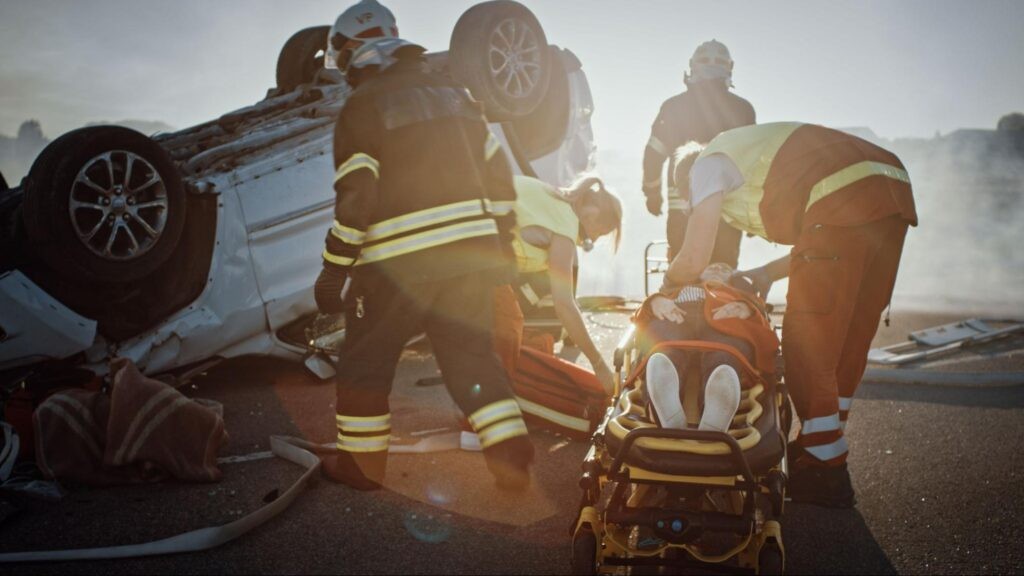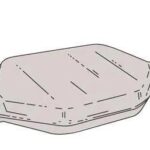SUV rollover accidents are undeniably dangerous, leading to severe injuries and fatalities. Due to their design characteristics, SUVs inherently have a higher center of gravity compared to sedans, making them more susceptible to rollovers. However, advancements in automotive technology have introduced specific car parts designed to mitigate this risk. Understanding these parts and practicing safe driving habits are crucial for preventing rollover accidents.
 Wrecked SUV on its side after a rollover accident, emphasizing the critical role of car parts like Electronic Stability Control in preventing such incidents.
Wrecked SUV on its side after a rollover accident, emphasizing the critical role of car parts like Electronic Stability Control in preventing such incidents.
Understanding Vehicle Rollovers
A vehicle rollover occurs when a car tips over onto its side or roof. These accidents can be triggered by various factors during a collision, such as impact with another vehicle, stationary objects like guard rails or curbs, or even due to sharp turns and uneven road surfaces. Rollover crashes are statistically more dangerous than many other types of accidents because they often result in more significant vehicle deformation and can compromise the effectiveness of standard safety features. Occupants are at higher risk of serious injury due to the unpredictable nature of vehicle movement during a rollover.
Why SUVs Are More Prone to Rollovers
The heightened risk of rollovers in SUVs primarily stems from their design. SUVs are built taller than passenger cars, providing increased ground clearance and interior space. However, this design choice elevates their center of gravity. Imagine a taller object versus a shorter, wider object – the taller one is easier to tip over. SUVs, with their higher center of gravity and relatively narrower track width compared to their height, are inherently more top-heavy. This means that during sudden maneuvers or collisions, the forces acting on the vehicle are more likely to cause it to roll.
Key Car Parts That Prevent Rollovers
Fortunately, modern vehicles, especially SUVs, are increasingly equipped with sophisticated systems designed to prevent rollovers. These systems often work automatically, intervening when they detect conditions that could lead to a rollover. The most significant car part in preventing rollovers is Electronic Stability Control (ESC).
Electronic Stability Control (ESC)
Electronic Stability Control is a computerized technology that enhances a vehicle’s stability by detecting and reducing loss of traction (skidding). It doesn’t directly prevent the initial event that might lead to a rollover, but it dramatically improves the driver’s ability to maintain control and avoid situations where a rollover becomes likely.
ESC works by constantly monitoring the vehicle’s direction and comparing it to the driver’s intended steering input. If ESC detects that the vehicle is starting to swerve or lose directional control (a common precursor to rollovers, especially in SUVs during emergency maneuvers), it selectively applies the brakes to individual wheels and can also reduce engine power to help steer the vehicle back onto its intended path. By preventing loss of control, ESC significantly reduces the likelihood of a rollover.
Anti-Roll Bars (Sway Bars)
While not as technologically advanced as ESC, anti-roll bars, also known as sway bars, are crucial mechanical components that contribute to rollover resistance. These are torsion springs that connect the left and right wheels through the suspension system. Their primary function is to reduce body roll during cornering.
When a vehicle corners, centrifugal force causes the body to lean outwards. Anti-roll bars resist this body roll by transferring force from one side of the suspension to the other. By limiting body roll, they help keep the vehicle flatter during turns, which is vital for maintaining stability and preventing rollovers, especially in taller vehicles like SUVs. While anti-roll bars are a passive system and always active, they work in conjunction with systems like ESC to provide a comprehensive approach to vehicle stability.
Other Ways to Prevent Rollover Accidents
Beyond specific car parts, driver behavior and vehicle maintenance play crucial roles in preventing rollover accidents.
-
Drive with Caution and Avoid Distractions: Attentive driving is paramount. Distractions take your focus away from the road and reduce reaction time. Being alert allows you to anticipate hazards and react smoothly, reducing the need for sudden, drastic maneuvers that can lead to rollovers.
-
Never Drive Under the Influence of Alcohol or Drugs: Impaired driving significantly increases the risk of all types of accidents, including rollovers. Alcohol and drugs impair judgment, slow reaction times, and affect coordination, all of which are critical for safe vehicle operation and avoiding loss of control.
-
Adhere to Speed Limits: Speed is a major contributing factor in rollover accidents. Excessive speed reduces the time available to react to unexpected situations and increases the severity of any loss of control. Speed limits are designed for safe driving conditions, and exceeding them, especially in SUVs, dramatically elevates rollover risk.
-
Load Your SUV Carefully: Improperly loaded cargo can significantly alter an SUV’s center of gravity and stability. Overloading and uneven weight distribution make an SUV more top-heavy and prone to tipping. Distribute weight evenly and secure cargo to minimize shifts during driving.
-
Maintain Your Tires: Tire condition is critical for vehicle control. Worn tires reduce traction, making it harder to control the vehicle, especially during emergency maneuvers or in adverse weather. Regularly check tire pressure and tread depth, and replace worn tires promptly.
Conclusion
While SUVs inherently possess a higher rollover risk due to their design, car manufacturers have implemented technologies like Electronic Stability Control and utilize components such as anti-roll bars to significantly enhance safety. Understanding the role of these car parts, combined with adopting safe driving practices and maintaining your vehicle properly, are the most effective ways to prevent rollover accidents and ensure safer journeys for yourself and your passengers. Prioritizing safety features when choosing a vehicle and consistently practicing responsible driving habits are key to mitigating the risks associated with SUV rollovers.
References
National Highway Traffic Safety Administration (NHTSA). (April 2022). Characteristics of Fatal Rollover Crashes.
National Highway Traffic Safety Administration (NHTSA). Alcohol and Driving.
Vincent, John M., (20 May 2022) U.S. News. The 14 Safest SUVs for 2022.
